
Patented Gradient Light Interference Microscopy (GLIM) is implemented as an add-on to the camera port of your research microscope (Zeiss, Nikon, Leica, Evident) for any magnification and immersion (10X-100X, dry or water/oil and more). GLIM collects live, label-free and quantitative information (morphology, dry mass, RI) with subcellular resolution from milliseconds to days. Phi Optics CellVista GLIM modules provide high SNR with no speckles background, optical sectioning for 3D tomography in optically thick specimens: organoids, embryos, small model animals, plant tissue and more. Drug discovery, proliferation, viability, cytotoxicity, immune cell killing, and more assays can be done with sub-cellular resolution. Use regular sample holders (single or multi-wells) or microfluidics with minimal or no sample preparation. Correlative imaging (GLIM and fluorescence) can be acquired with same large field of view, high QE camera for pixel level multi-channel registration to input into latest machine learning models.